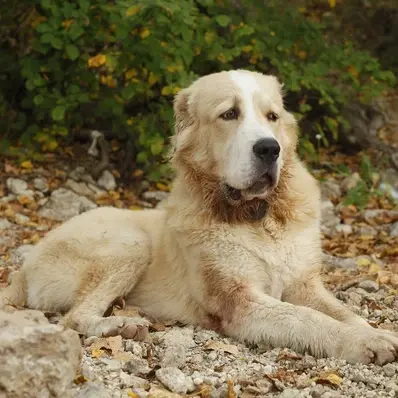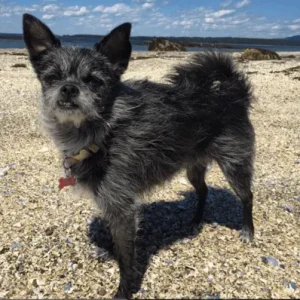Central Asian Shepherd Dog History/Origin
Central Asian Shepherds are considered one of the oldest dog groups, with a history spanning over 5,000 years based on artifacts from their native lands. Unlike many modern breeds, they weren’t created by humans or specific countries.
Instead, they were shaped by the climate and culture of ancient, uncivilized times.Different types of CASDs can be found across terrains from Mongolia’s mountains to the Kara Kum deserts.
Their history intertwines with human civilization, traceable through the ancient Silk Road. To understand their past, one must consider the harsh conditions and dangers that early humans and these dogs faced, including extreme climates and predators.
Today, nomadic tribes use these dogs as guard dogs to protect their families and traditional transportation like camels and horses. Recently, these dogs have been incorrectly classified as traditional livestock guardians, but they are true territorial guardians bred to protect people and their possessions.
Central Asian Shepherd Dog History- Source: AKC.org
These purebred dogs bond with humans first, making them devoted protectors of their perceived territory. The Central Asian Shepherd Dog is known for his innate abilities as a livestock guardian dog, protecting his herd with dedication and vigilance.
In modern times, the breed has seen divisions and the creation of new types. The former USSR standardized the breed in the 1920s, but a new Russian standard developed after the USSR’s collapse led to the Central Asian Ovcharka.
They’re closely related to the Tibetan Mastiff. This modern version differs from the aboriginal types found in Central Asia in size, color, and temperament, marking a clear distinction between native and Russian-bred dogs.
Central Asian Shepherd Dog Personality
The Central Asian Shepherd Dog is pne of the dog breeds that is proud, confident, and independent. These dogs are courageous, never backing down when faced with a predator. Their strong territorial instincts ensure their lands remain free from unwanted critters and threats.
Their self-assured demeanor reflects their ancient heritage and ability to adapt to challenging environments.
- Temperament
Loyal and protective, the Central Asian Shepherd Dog bonds closely with their family while remaining aloof from strangers. Despite their reserved nature, they are affectionate with family members. These dogs are sturdy, well-suited to cold climates, and generally quiet. They become active and vigilant outdoors, yet maintain a mellow and observant demeanor indoors, making them balanced companions.
- Potential Challenges
Owning a Central Asian Shepherd Dog requires managing their strong protective instincts and territorial nature. They need experienced owners who provide firm, consistent training and early socialization. Their aloofness with strangers and need for outdoor activity may pose challenges for first-time dog owners. Proper exercise helps channel their natural guarding instincts, ensuring they become reliable companions.
Central Asian Shepherd Dog Physical Appearance
The Central Asian Shepherd Dog is a large breed with a massive bone structure and powerful muscles. Its body is slightly longer than it is tall, and it has a massive head. The ears, often cropped close to the head, are naturally small, drop, and set low. The tail is set high, thick at the base, and, when left undocked, hangs down to the hock in a sickle shape.
- Size
The Central Asian Shepherd Dog should weigh between 88 and 110 pounds. They stand between 24 and 28 inches at the shoulders.
- Coat color
The Central Asian Shepherd Dog exhibits a diverse array of coat colors, with the most prevalent being white, fawn, black, and brindle. These colors may appear in solid shades or blend in various combinations. Their coats are characterized by a medium length, straight texture, and dense fur, protecting them from harsh climates and outdoor elements.
White Central Asian Shepherd Dog- Source: AKC.org
White Central Asian Shepherd Dog with brown patches – Source: AKC.org
Brindle Central Asian Shepherd Dog- Source: alabai.world
Pied Central Asian Shepherd Dog- Source: central_asian_shepherd.dog
Black Central Asian Shepherd Dog- Source: kennel_alsvihouse
Central Asian Shepherd Dog Gender Differences
Male Central Asian Shepherd Dogs generally have larger dimensions in height and weight than females. Variations in size can occur within the breed, with some dogs being smaller or larger than the typical breed standard. This variability in size should be considered when choosing a Central Asian Shepherd Dog based on individual preferences and living conditions.
Central Asian Shepherd Dog Feed/Nutrition
An ideal diet for the Central Asian Shepherd Dog should cater to their large size and moderate energy levels. It’s recommended to feed them high-quality commercial dog food or a balanced homemade diet once daily, adjusted as per your vet’s guidance regarding portion sizes and feeding frequency.
Due to their tendency to gain weight if overfed, it’s crucial to maintain a regular feeding schedule and avoid leaving food out throughout the day. Limiting treats is also advisable to manage their calorie intake effectively.
As with all dogs, the dietary needs of the Central Asian Shepherd Dog evolve from puppyhood through adulthood and into their senior years. Adding pineapple as an occasional treat can be refreshing, but make sure to serve it in moderation and remove the core and skin.
Central Asian Shepherd Dog Health
Natural selection has contributed to the Central Asian Shepherd Dog’s genetic resilience, resulting in overall robust health without breed-specific ailments. However, their large size predisposes them to several potential health issues:
- Hip Dysplasia: This condition arises from an improper fit of the hip joint in the socket, leading to arthritis and hindering mobility. Regular veterinary check-ups and maintaining a healthy weight can help manage this condition.
- Von Willebrand’s Disease: A hereditary bleeding disorder, Von Willebrand’s Disease is caused by a deficiency in a blood clotting protein. Dogs with this condition may experience prolonged bleeding after injuries or surgeries. Affected dogs must receive prompt veterinary care and avoid activities that could lead to injury.
- Canine Gastric Torsion: Bloat is a life-threatening condition where the stomach fills with gas and twists upon itself. Immediate veterinary attention is necessary to relieve the pressure, as GDV can lead to shock, organ damage, and even death without prompt intervention.
- Progressive Retinal Atrophy: This group of inherited eye diseases causes the gradual deterioration of the retina, resulting in progressive vision loss and potential blindness. Regular eye exams by a veterinary ophthalmologist can help monitor and manage this condition to maintain the dog’s quality of life.
Central Asian Shepherd Dog Care and Grooming
While not suitable for allergy sufferers, the Central Asian Shepherd Dog is low-maintenance when it comes to grooming. Their coats typically require brushing once a week and occasional baths to keep them in optimal condition.
The coat of the Central Asian Shepherd Dog undergoes seasonal changes, becoming sparser in summer and thicker in winter, often developing a dense undercoat during colder months. They experience an annual shedding phase known as “the fur storm,” necessitating regular vacuuming or consideration of robot vacuums for cleaning.
In terms of exercise, the Central Asian Shepherd Dog needs daily physical activity. Ideally, they should get at least an hour of walking or hiking each day.
Regular veterinary checkups are crucial for their health, and your vet can help create a personalized care plan to keep them in top shape. Additionally, training your dog not to bark excessively can help ensure a peaceful environment.
Central Asian Shepherd Dog Rescue Groups
Rescue groups dedicated to Central Asian Shepherd Dogs provide a vital lifeline for these loyal and protective breeds in need of homes. They offer adoption opportunities, rehabilitation, and support to ensure these dogs find loving families that understand their unique needs. Supporting rescue groups helps in giving these remarkable dogs a second chance at a happy and fulfilling life.
Central Asian Shepherd Dog Price
The price of a Central Asian Shepherd Dog typically ranges from $1,200 to $2,000, depending on factors such as breeder reputation, pedigree, and location.
When looking to buy a Central Asian Shepherd Dog (CASD), it’s crucial to find a reputable breeder who prioritizes the health and well-being of their dogs. Such breeders conduct thorough health checks on their puppies to ensure they are free from genetic disorders and other health issues.
Interesting Facts
- The Central Asian Shepherd (CAS), also known as Alabay or Alabai, differs from many modern dog breeds in its origins. It did not primarily originate through human intervention.
- In addition to their role as guardians, CAS dogs are also skilled hunters and have been used for hunting large game like wolves and wild boars.
- They have been featured in the KUG Dog Show 2021.
Best For
The Central Asian Shepherd Dog (CAS) is best for experienced owners who can handle large, independent breeds. They thrive in homes with space to roam and need consistent training and socialization. CAS dogs are loyal and protective of their families, making them ideal for rural settings or homes with secure yards.
Top Names
| Male Central Asian Shepherd Dog Names | Female Central Asian Shepherd Dog Names |
| Maximus | Valkyrie |
| Titan | Zara |
| Bear | Sasha |
| Thor | Luna |
| Khan | Nika |








 Central Asian Shepherd Dog History- Source:
Central Asian Shepherd Dog History- Source: 

 White Central Asian Shepherd Dog- Source:
White Central Asian Shepherd Dog- Source:  White Central Asian Shepherd Dog with brown patches – Source:
White Central Asian Shepherd Dog with brown patches – Source:  Brindle Central Asian Shepherd Dog- Source:
Brindle Central Asian Shepherd Dog- Source:  Pied Central Asian Shepherd Dog- Source:
Pied Central Asian Shepherd Dog- Source:  Black Central Asian Shepherd Dog- Source:
Black Central Asian Shepherd Dog- Source: 







